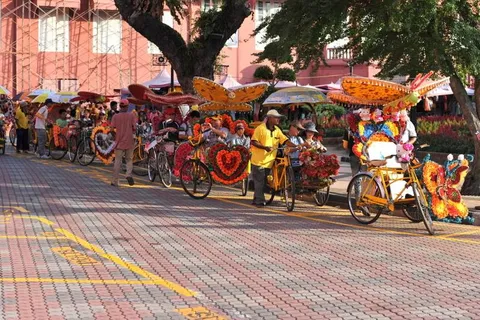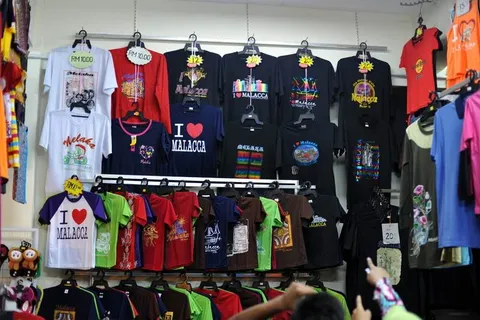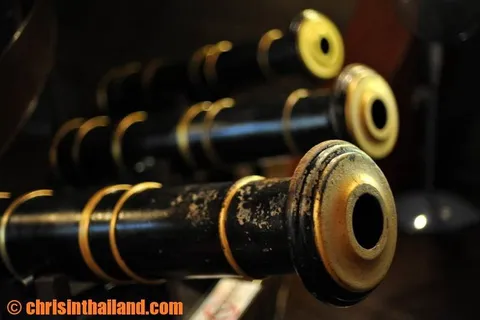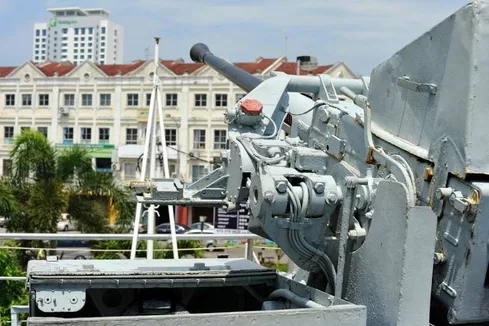Call it Malacca or Malaka if you like.
It really doesn’t matter, since they sound identical and you’ll see both in roughly equal quantities. Named a UNESCO World Heritage City in 2008, the city is daytrippable from Kuala Lumpur — once you arrive in the appropriate area a 10 minute bus from the terminal, your sandaled feet are enough to get you around and about.
The city is currently in a bit of a crossroads right now. On one hand, the UNESCO appellation summons tourists from around the world, seeking to take in some of the area’s history. On the other hand, tourists bring money and the desire to party, which gives rise to a recently-opened Hard Rock Cafe. There’s precious little else around with a corporate logo, however, and thankfully the overpriced establishment requires some looking to find.
The area owes its existence to the Chinese, the Dutch, the British, and boatloads of sailors. Melaka’s port was frequented by merchants across the East, and in 1405 Admiral Cheng Ho brought gifts from the Ming emperor. He promised protection from Siam, and plenty of Chinese settlers called it home. In 1511, the Portuguese conquered the town, but the Catholics couldn’t force (or convince) the Muslim merchants to continue using their port. Melaka later was controlled by the Dutch for 150 years, and over time their allies (the British) gained permanent control. From there the British expanded their control, though their interest in Melaka waned as Singapore grew faster.

The more recent history of Japan’s conquering of China and Malaka in the 20th century is recorded and recognized at a memorial along the main road. There’s one very unfortunate English error in the sign above, however, which really should have been caught before the expense of creating the sign…

The Church of St. Francis Xavier — built in 1849 and dedicated to you-guessed-it, it’s mainly open for masses and not the mass of tourists. As a result, the layman will have to enjoy the view through the gates, including a couple of sculptures of St. Francis Xavier and Yajiro (a Japanese disciple who spread Christianity throughout Japan). By the time you reach this wonderful building you’ll have walked through a fairly non-descript area referring to itself as Little India — a straight block of stores and a few restaurants.

It’s approaching the water that some of the ostentatiousness comes out to be seen. The brightly colored bicycle powered trishaws all but ensure you’ll see them from 100 meters away. More than likely you’ll hear them first, their loudspeakers pumping out everything from Michael Jackson’s ‘Thriller’ to the now infamous Gangnam Style.

Presenting St. Paul’s Church, or rather’s what left. Originally built by Duato Coelho, the Portuguese sea captain gave thanks for surviving enemy attacks and dedicated it to the Virgin Mary. After Father Francis Xavier died, he was laid to rest here before being moved to India. Over the centuries, the structure became a Dutch Protestant church, a Portuguese fortress, a mausoleum for Dutch and Portuguese bigwigs, and an ammunition depot for the British.

What do you want on your tombstone? (If you said ‘pepperoni’ or another pizza topping, pat yourself for knowing 1990’s American culture, then sit down and think about it). Some of the stones had trilingual translations, mainly sharing their name, occupations, and important dates. I do wish there was a bit more protection of these finely chiseled pieces — in 20 minutes of meandering I saw at least three children attempting to climb them.

Not too far away is a two-story building offering dozens of t-shirt designs, along with the typical tacky pieces of plastic I’m surprised people still buy. It’s easy enough to avoid, but head up to the second floor for essentials like drinks and snacks.

Along with the site of the Malacca fort, the water wheel serves to channel water for the traders. At any one point, up to 2,000 ships were docked here.

A look at the Maritime Museums Complex (Kompleks Muzium Samudera) — across the street from the aforementioned two-story souvenir shop. Like most museums in Malacca, you’ll want to visit from 9am-5pm, though this area is open later on weekends.
Opened in June 1994, there’s plenty of history to go over — and there’s plenty to take in. Four eras are specifically highlighted in roughly chronological order, complete with exhibits and text-heavy panels.

Cannons, anyone? The Portuguese were the first Europeans to land at the port in the early sixteenth century, and while I personally thinks it sounds melodramatic, this signaled the beginning of the end of the Malaka Sultanate.

A look at the outside and looking up. You can meander a bit on the top deck, but there isn’t much here to see.

Your next, and most logical step, is the other exhibition hall next door. While also focused on history, it’s also focused on the preservation and conservation of the local wildlife:

Why, yes they do — too many fins spoil the broth…

Information panels about Malacca’s marine heritage as part of a larger room.

Head up to the next area — not exactly the most intuitive to find — for something completely different — dinosaur eggs, anyone?
Also around: meteors — because meteors are what everyone thinks of when you think of a maritime museum…
Next up: the Muzium TLDM
As part of the ticket to the Maritime Museum, your third museum is the Muzium TLDM, one part vehicles and one part ‘the way things were’.

The helicopter above, while being the main display on the ground floor, just barely fits inside the room — the blades couldn’t even do a complete rotation. This is the WASP HAS Mark I, in case you were curious.

The winner is the one who can name most of the knots. GO!

I always love seeing (hopefully) decommissioned and unloaded weapons pointing square at perfectly good buildings. Not pictured here is a ship, still in decent order and worth a couple minutes of your time.
Part of Malacca’s claim to fame are all the museums, each a short walk from the previous. Some of them are better than others; a case in point is the Malaysian Youth Museum.
The museum is dedicated to the youth in the country and the changes they can bring. There’s plenty of information about the dozens of organizations and their goals, but for the most part this museum is utterly boring. Connected, however, is the Melaka Art Gallery on the 2nd floor (one admission covers both museums):
While nothing would be described as ‘profound’, it’s a pleasant and air-conditioned distraction.
Next up: the People’s Museum
A few minutes walk away is the People’s Museum (Muzium Rakyat) — and this is perhaps the highlight of the day. Opened April 1992, the building dates from the 1960’s and was formerly the Melaka Central District Municipal Council.

It’s actually three different museums in one building, and it may look like the transitions are rather jarring. The people’s museum on the first floor covers the history of the people — one that’s changed over the centuries, of course, and one that requires a fair bit of explanation to understand where they are today.

Some different hair styles, anyone? Not pictured are plenty of traditional colorful clothes, including a couple that look straight out of an European style book.
Next up, the kite museum — focusing on the history and creation of kites, ‘traditional games’ are lumped in here as well. The kites were used in the field after rice was harvested, and were perhaps a bright spot in the life.

Just a few of the many kites around.
The third floor is the most bizarre — I really do wonder what they were thinking here. Called the Beauty Museum, the exhibits talk extensively about the lengths people go to for ‘beauty’:

Nothing quite like some lip plates to make someone look beautiful…?

Neck stretching, anyone? The exhibits offered up mostly pictures and text — thankfully, these are two processes that are slowly dying over time.

The corset — loved by men for the shape they give women, perhaps loathed by women for the discomfort they bring. Don’t forget about the foot binding and head binding, along with an odd set of exhibits on ‘outstanding Melaka-Eurasian personalities’. It’s as though space was available to store / show a number of items, and it didn’t really matter whether they went together.

Finally, there’s the Malaysia Architecture Museum (Muzium Seni Bina Malaysia). Open to the public for free in 2004, the museum aims to show the traditional styles from the country’s past. The building itself dates from the 18th century, and served as a residence and administrative center for Dutch officials. It’s straightforward enough, informative, and like all the other museum has plenty of information in English.
You could easily spend a full weekend meandering the several square-block area and still not see everything. Pick and choose to make the most of your time, and understand that renovation will close some areas some of the time. It’s well worth the visit whenever you can go.
Name: the museums of Malacca / Malaka
Address: for the People’s Museum (a good starting point) — Jalan Kota, Bandar Hilir, 75000 Melaka, Malaysia (GPS: 2.191793,102.249122)
Directions: Plenty of buses head to Malaka from Kuala Lumpur. Once at Melaka Sentral, head to the other side of the bus terminal for the local buses. Bus 17 gets you to the area — keep your eyes out for the signs. The closer you get to the quayside, the better.
Hours: Most museums open 9am or 10am to 5pm or 6pm.
Admission: Varies — free to 6 ringgit is the average. The Maritime Museum, for example, is 6 ringgit, and that ticket enables admission to two other exhibits (average it to 2 ringgit apiece if you like)
Phone: 06–286–5311 (for the People’s Museum)
Website: http://amazingmelaka.com (unofficial site)


